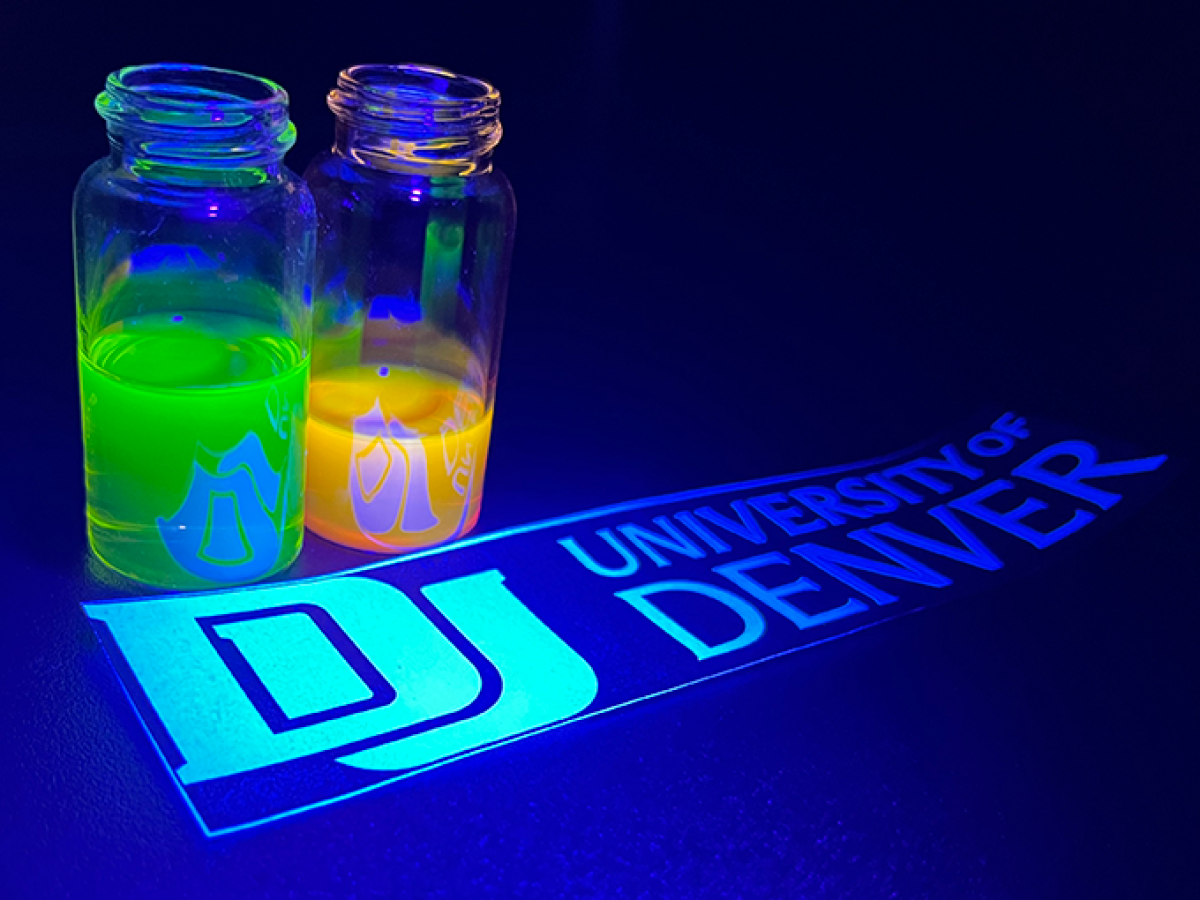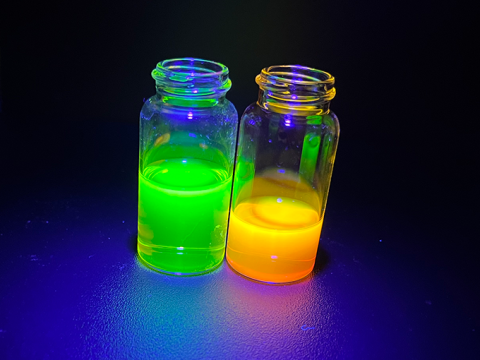DU Organic Chemistry Lab Explores New Territory With Molecular Probes

Brian Michel makes molecular probes, smart molecules that glow when they find their target.
Michel’s research group recently published a paper about a shifting emission of their probes from green light to orange. “This is cool, and it has applications,” says Michel, an associate professor of chemistry and biochemistry at the University of Denver’s College of Natural Sciences and Mathematics.
The National Institutes of Health has awarded a $1.8 million grant over five years to Michel to continue developing ever-more-sensitive molecular probes for detecting ethylene, a hydrocarbon gas, in mammals. Ethylene is well-known in plants for the role it plays in ripening, but the role of ethylene in mammalian biology has received relatively little scientific attention.
“When we think about the molecules we exhale from our breath, hydrocarbons are not usually one of the things we think about. We think about things like carbon dioxide or oxygen,” Michel says. But small molecules such as ethylene can provide insight into whether someone suffers from oxidative stress, which occurs when there is an imbalance of free radicals and antioxidant defenses—and is a possible disease indicator.
“People have proposed that it’s a biomarker of oxidative stress, but the tools to look at that are limited. We come in as tool developers, with the organometallic chemistry behind that, and how to apply that in different systems,” Michel says.
One such application could serve as a useful and more cost-effective assay—or test—for biologists and biochemists in their experiments. The laser photoacoustic spectrometers they currently use are a rather expensive way to detect ethylene in mammals.
“There are only a handful of these in the world,” Michel says. “If we can make a molecule or a couple of molecules that we can ship in a little vial to people, and anybody can run these assays in their labs, then we can potentially start answering more questions about any roles ethylene has in biological systems.”
Michel’s new NIH grant funds the broad sweep of his lab’s research. This includes developing ethylene detection tools based on organometallic reactions. “The way we go about doing it is unique compared to how other people develop probe-type molecules,” he says.
Michel first heard of work in this field as an undergraduate, when the 2005 Nobel Prize in Chemistry was awarded “for the development of the metathesis method in organic synthesis.” Metathesis is often described as a way that atoms “exchange dance partners” to form new molecules.
Nearly 20 years later, Michel uses metathesis for entirely new applications. This builds on his PhD background in traditional catalysis — methods for speeding chemical reaction rates. Then, as a postdoctoral scientist, he did similar work using palladium to detect carbon monoxide in cells.
As an independent research scientist, Michel learned of the need to find a better way to detect ethylene. His group has developed an array of probes since publishing its first paper in this field in 2018.
“We’re always looking to do new things with them. Some of the new things are just steady, systematic improvements,” he says. “We also think about how we can take fundamentally different approaches. Is there a different way we can look at the detection systems that might have its own issues but might offer other unique advantages?”
As Michel began exploring ideas about how to detect ethylene, he noticed that smaller alkenes—a class of hydrocarbons also known as olefins—generally react faster than larger alkenes. As the smallest possible alkene, ethylene reacts quite quickly.
Many scientists view ethylene as a problem in olefin metathesis but, Michel says, “We’ve found a way to take advantage of how it reacts a bit differently than some other molecules around it due to its small size.”
In developing his probes, Michel applies chemical reactions that operate separately from those used by mammalian systems, yet do not affect their cells. This growing field goes by names such as “new-to-nature organic reactions,” “chemical biology,” or “developing chemical tools to study biological systems.”
“The reason we do this is that the molecules we’re trying to detect … aren’t reactive enough to react with other organic molecules by themselves,” he explains.
A group of chemical elements called transition metals can help. The human body contains various transition metals, including copper, manganese and iron that perform important functions. Iron, for example, transports oxygen.
“Transition metals have some additional bonding interactions with these small molecules that allow for chemistry to occur that doesn’t happen already in biological systems,” he says.
Striving for the perfect system looms as a constant challenge for Michel’s group. “Why is this one thing not quite fast enough? How do we make it faster? Why do we not get quite as much signal here?”
And troubleshooting the issues that arise with a highly sensitive detection system brings its own challenges, Michel says. “It’s getting so sensitive that finding what’s causing things to go wrong becomes harder and harder.”









